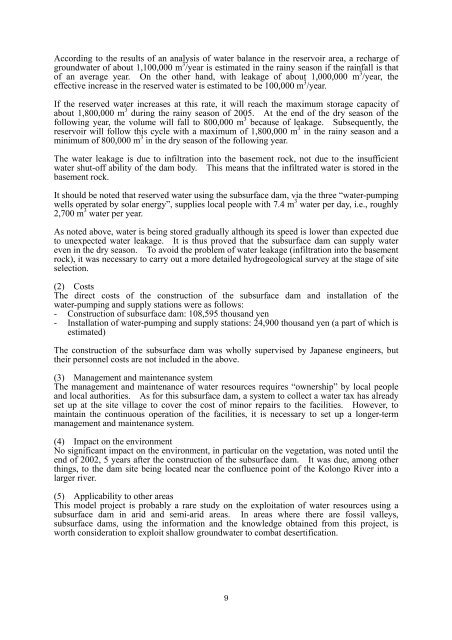SubSurface Dams - Sustainable Sanitation and Water Management ...
SubSurface Dams - Sustainable Sanitation and Water Management ...
SubSurface Dams - Sustainable Sanitation and Water Management ...
Create successful ePaper yourself
Turn your PDF publications into a flip-book with our unique Google optimized e-Paper software.
According to the results of an analysis of water balance in the reservoir area, a recharge ofgroundwater of about 1,100,000 m 3 /year is estimated in the rainy season if the rainfall is thatof an average year. On the other h<strong>and</strong>, with leakage of about 1,000,000 m 3 /year, theeffective increase in the reserved water is estimated to be 100,000 m 3 /year.If the reserved water increases at this rate, it will reach the maximum storage capacity ofabout 1,800,000 m 3 during the rainy season of 2005. At the end of the dry season of thefollowing year, the volume will fall to 800,000 m 3 because of leakage. Subsequently, thereservoir will follow this cycle with a maximum of 1,800,000 m 3 in the rainy season <strong>and</strong> aminimum of 800,000 m 3 in the dry season of the following year.The water leakage is due to infiltration into the basement rock, not due to the insufficientwater shut-off ability of the dam body. This means that the infiltrated water is stored in thebasement rock.It should be noted that reserved water using the subsurface dam, via the three “water-pumpingwells operated by solar energy”, supplies local people with 7.4 m 3 water per day, i.e., roughly2,700 m 3 water per year.As noted above, water is being stored gradually although its speed is lower than expected dueto unexpected water leakage. It is thus proved that the subsurface dam can supply watereven in the dry season. To avoid the problem of water leakage (infiltration into the basementrock), it was necessary to carry out a more detailed hydrogeological survey at the stage of siteselection.(2) CostsThe direct costs of the construction of the subsurface dam <strong>and</strong> installation of thewater-pumping <strong>and</strong> supply stations were as follows:- Construction of subsurface dam: 108,595 thous<strong>and</strong> yen- Installation of water-pumping <strong>and</strong> supply stations: 24,900 thous<strong>and</strong> yen (a part of which isestimated)The construction of the subsurface dam was wholly supervised by Japanese engineers, buttheir personnel costs are not included in the above.(3) <strong>Management</strong> <strong>and</strong> maintenance systemThe management <strong>and</strong> maintenance of water resources requires “ownership” by local people<strong>and</strong> local authorities. As for this subsurface dam, a system to collect a water tax has alreadyset up at the site village to cover the cost of minor repairs to the facilities. However, tomaintain the continuous operation of the facilities, it is necessary to set up a longer-termmanagement <strong>and</strong> maintenance system.(4) Impact on the environmentNo significant impact on the environment, in particular on the vegetation, was noted until theend of 2002, 5 years after the construction of the subsurface dam. It was due, among otherthings, to the dam site being located near the confluence point of the Kolongo River into alarger river.(5) Applicability to other areasThis model project is probably a rare study on the exploitation of water resources using asubsurface dam in arid <strong>and</strong> semi-arid areas. In areas where there are fossil valleys,subsurface dams, using the information <strong>and</strong> the knowledge obtained from this project, isworth consideration to exploit shallow groundwater to combat desertification.9
















